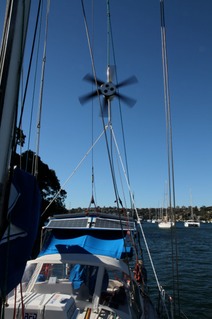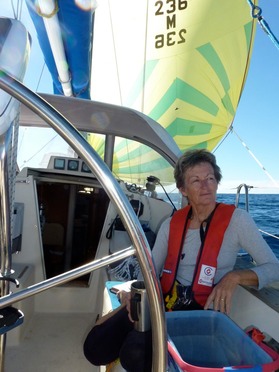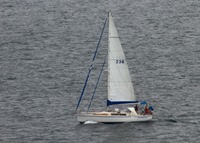We spent along time preparing for our cruising life, starting as novices and learning a lot along the way. We still think of ourselves as learners and probably will do so until we stop cruising; but we thought that it would be useful to share our thoughts on the things which, in hindsight, we found to be important decisions.
We sailed back through Sydney Heads at 2200 on 19 December 2012 after 4500 nautical miles of coastal and ocean sailing since we left Melbourne in November 2011. It was a wonderful trip, which saw us sailing from Melbourne to Sydney in November 2011, visiting the beautiful little fishing ports of the East coast along the way – Refuge Cove to Eden - to Bermagui - to Jervis Bay - to Ulladulla - to Port Hacking - and finally to Sydney Harbour. We stopped in Sydney for 6 months before we sailed 250 miles north to Coffs Harbour and so entered the Coral Sea in June 2012and arrived in Noumea 8 days later.
After enjoying the delights of French colonialism - the wine, cheese and ambience, including the Bastille Day Parade which was fabulous - we headed east to Vanuatu. This was the highlight of the trip without doubt! The volcano and culture of Tanna, the turtles and dugongs of Lamen Bay, the beauty of the Maskelyne Islands, the diving and World War 11 relics on Santo were only surpassed by the welcome of the wonderful Vanuatu people. We were reluctant to turn New Horizons towards Bundaberg in late October but were pleased to be home with family and children for Christmas.
We could spend a long time doing a chronology of the amazing places we have visited. However we thought it might be more useful to share with our fellow cruisers a few perspectives on what we, as apprentices to the cruising game learnt in the last 2 years as we prepared our boat for the adventure of our lives.
As we prepared New Horizons we were constantly faced with choices as to what we needed to get right before the big adventure - what we must do to ensure that the boat was as best it could be, and what we needed to know. Sailing is always about making choices, making the right decision, making compromises to get it right. These are our thoughts on getting it right. These are not earth-shattering ideas, just reflections of the 2 of us after we equipped a boat and headed off to pursue a sailing dream.
There are 3 sets of things we thought we might share.
• Before you leave • Equipment choices • How you travel
Before you leave
1. The most important thing we found was to choose a date and stick to it! It's so hard when you have full working lives and families and 1000 reasons to stay to finally cast off lines and head off into the ocean. Without a date it won't happen. We chose, whimsically, the 11th of the 11th 2011.
2. Live on your boat before you go. We moved on to New Horizons in March 2011, 8 months before we left. So we had many months to figure out how to pack, where to put things, and where to find things when you really need them. It's amazing how quickly you change your priorities and discover the art of packing by frequency of use rather than by category. By definition no matter what size boat you have it will be full before you leave. All you need is to be able to get things quickly or you will, just as quickly, go stark raving nuts!
3.Buy a boat that you can trust. We were “fleet owners” (i.e. 2 boats!) for over a year as a cosequence of buying one boat for coastal cruising and then deciding that we wanted a different one for offshore cruising. We cast about looking for a boat we wanted to take with us - or more accurately, the boat that we wanted to take us with it! We wanted to know that if things ever got rough we would have absolute confidence in the boat. In the end we figured that if Kay Cottee was happy to circumnavigate by herself through the Roaring Forties, and indeed the 50s, in a Cavalier 37 then that would do us for the Pacific. We were happy with our choice, because things do, and did, get rough occasionally.
Equipment choices
4. Get the right sail plan. We put all new sails on New Horizons before we left, but perhaps the most important decision was to add an inner forestay - the staysail on a furler was the best decision we made. We used it regularly and it had a marvellous effect on the boat, bringing the centre of effort back towards the mast and reducing the power in the rig and taking the load off the autohelm.
It was great to have a new Genoa and Main; and the recut spinnaker on a furler was a wonderful sight flying in front of us; but if we were to say we have learnt one thing as novice cruisers it would be that you don't overpower your boat and you don't go to sea without a staysail.
We would also have to say that we set up the 3 reefs in the main so that we could do everything, including pulling down the main completely, from the cockpit. It was great to be able to avoid the journey along the pitching deck when reefing or removing the main was called for.
5. There is nothing that beats the security of knowing that your anchor is not going to drag.

We put a Sarca on 60m of chain as our primary anchor and it never dragged - not once. We also had a backup CQR on 60m of chain. In addition we had a stern anchor, a Bruce on 10m of the chain and 45m rode. We did use the stern anchor several times and we spent one 24-hour period hanging off the stern anchor when the wind changed and came around behind us at 27kts. Don't risk it. Carry plenty of anchors and know how to deploy them.
6. Communication
The never-ending discussion that seemed to be around as we prepared New Horizons was whether to use a sat phone for e-mail or to get a modem for the HF radio. In the end we decided that since we already had the HF radio we may as well spend the $1500 on a 2nd form of communication, that is the sat phone, rather then simply enhancing the one that we had. This was one of those decisions that was really good and at the same time, really really bad!
We were happy with the decision to get a sat phone, but really unhappy with the decisions we made about getting a provider. Our first monthly bill was over $1000. In short a complete disaster! In the end we swapped providers and resolved the problem. We now have an Iridium 9575 sat phone, connected through a US company called OCENS and the e-mail provider is uuplus. We have found uuplus in particular to be wonderfully helpful. After spending far too much money on a completely lousy service we now rely on our satphone to get weather updates from Buoyweather twice a day. These e-mail exchanges used to cost us about $10 each time - they now cost us $0.45. The difference is real! Buyer beware!
7. Generating power
Of course we spent a long time tossing up whether we needed a generator or not. The positives of course relate to the availability of power. The negatives are about space, inconvenience, noise, and carrying around more flammable fuel. In the end we added 2 wonderful pieces of equipment and have been very happy with our choices. We had two 60W solar panels and we added 2 more 80W solar panels. The new ones are the flexible 1.5mm panels which have been zipped onto our Bimini. These are just great! We were reluctant to redesign our stern arch and add yet another 17 kg of solar panels. Instead by paying slightly more for the panels we have added virtually no weight to the boat and have maintained its current structural arrangements. With 280W solar we find that it is very, very rare that we need to start the engine to generate power.

The other wonderful piece of equipment that we brought is a tow/wind generator. The downside of relying on solar power is that there isn't a lot of it around in the middle of the night - just when you need it. At night you are running the chart plotters, the AIS, the radar, the computer, the wind instruments, the navigation lights, the auto helm, the fridge, water pumps - all with no power input. To solve this problem we bought a wonderful Aquair 100 wind and tow generator. When you fling this marvellous thing out the back of the boat it produces a good stream of power. The claim is something like 1 amp per every knot of speed over 3 kn. So as we cruised through the night on 5 to 6 kn we would be putting that number of amps back into the batteries. At anchor, you simply remove the tow line and its propeller and replace it with the wind vane and windmill blades and hoist the thing into the rigging. We haven’t installed a dedicated ammeter for this yet but the difference is clearly observable and I have to say it works a treat!
8. Don’t get Run Down - AIS
I'm not even going to comment on the need for a chartplotter and a good GPS. This is just basic equipment these days. As a matter of fact by the time you count the iPhones, iPads, inbuilt chart plotters, the computer and a handheld battery-operated GPS for emergencies we had 8 separate devices to give us our location. What you really do need though is a good AIS transponder - something that will not only tell you where other ships are but will let them know you're coming. We had a number of conversations with 900 foot ships which could have come within half a mile of us and as we passed Newcastle the AIS informed us of 26 ships at anchor and another 28 that were manoeuvring nearby. Do not try to go up the east coast of Australia without one.
How you travel
9. Take your time. We had intended sailing from Melbourne to Sydney and New Caledonia, through Vanuatu to the Solomons and the Louisiades and back to Cairns. We quickly abandoned this idea: you simply do not get to know the people and places by ticking them off on the log. Take your time so that you can meet the people, come to understand the places and cultures, and spend time with your fellow cruisers who will enrich you as they enriched us.
10. They say in the real estate business that there are 3 important things - location, location, location. We learnt that sailing is about the weather, the weather, the weather.
If you have a crew joining you they must understand you might make a decision not to leave an anchorage for a fortnight while you wait for the weather. We sat in Luganville in Vanuatu, watching various storms travel through the Tasman Sea and pushing 4 metre swells and 25kt plus winds all the way to New Caledonia. While we waited a fortnight another noted sailor who was the subject of an article in The Weekend Australian magazine called on emergency services to rescue him. This was a storm that was accurately predicted and unless you want to make yourself a name in the newspapers, stay put.
We made use of 2 different weather routing services - Commanders Weather in the United States and Bob McDavitt in New Zealand. We relied on Buoyweather for daily updates but found both Commanders and Bob McDavitt provided really useful passage forecasting.
11. Trust each other. Most of us seem to travel as a couple which means that essentially we are each solo sailors - we all need our sleep so while one is sleeping the other is on watch and managing the boat. Particularly if you are the skipper you need to be able to let go and rest when you need to, while your partner takes full command and makes the decisions. This respect for each other translates into all sorts of obvious behaviours. Unlike a racing crew, a good cruising couple never shouts and never blames. We watched many cruising couples as they wordlessly brought the boat into foreign marinas, anchored, changed sails and managed the boat in difficult conditions, able to smile and have a hug at the end of it.
12. And just to round it all off you know you've gone cruising when you're having fun. If you're not having fun, change something because you're not doing it right. The purpose of all this is to have a good time, day after day after day. And when you get back it's quite a shock to find everyone telling you that you have never looked better - we must have looked pretty ghastly when we left!
Go cruising! Have fun! Be bold! And, as Christine says,
“Dwell in Possibility"
So what now for the crew of New Horizons? Well, our shakedown cruise to the Pacific has convinced us that we need to keep going. We have decided that we would like to cruise the Mediterranean and then sail across the Atlantic, down the East Coast of the US through the Panama Canal and back across the Pacific to Australia. Sadly this means we need to sell New Horizons so that we can purchase a boat in Europe. An expensive decision but then that goes with boats doesn't it!?!
Perhaps that's the last thing we learned that we should pass on. As you prepare your boat you are investing in your life. You won't get your money back but the really good thing is you won't care.


